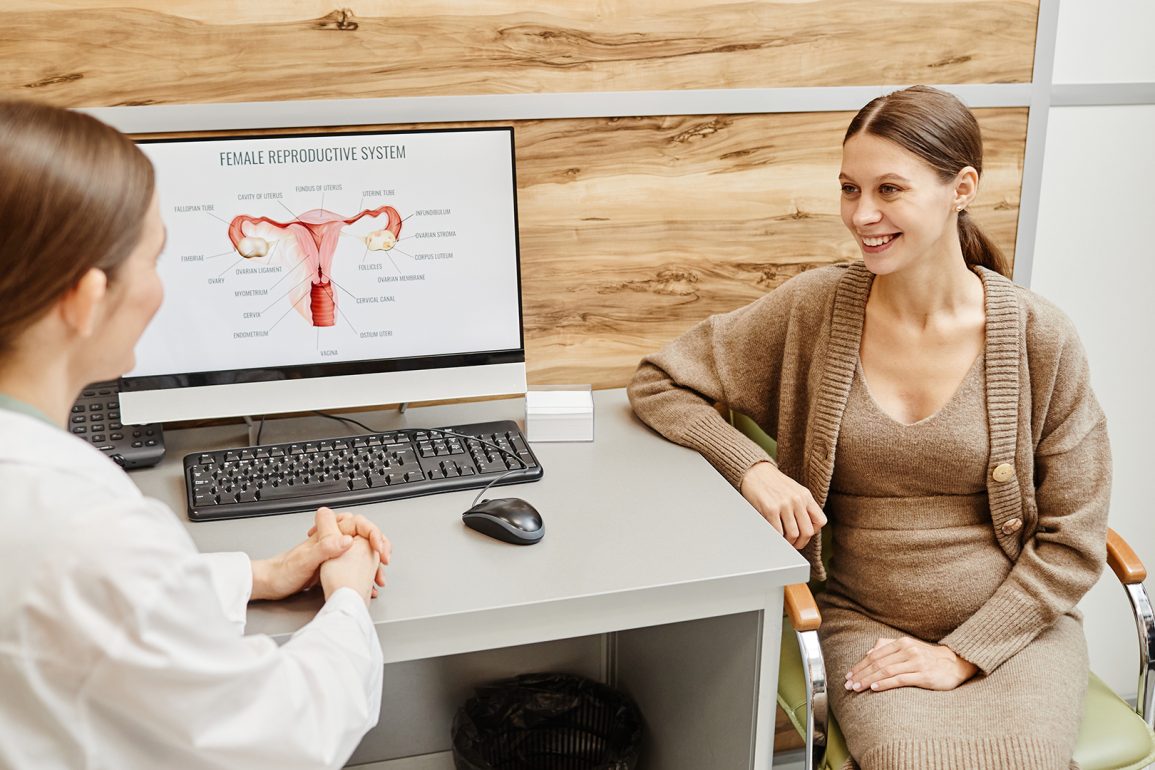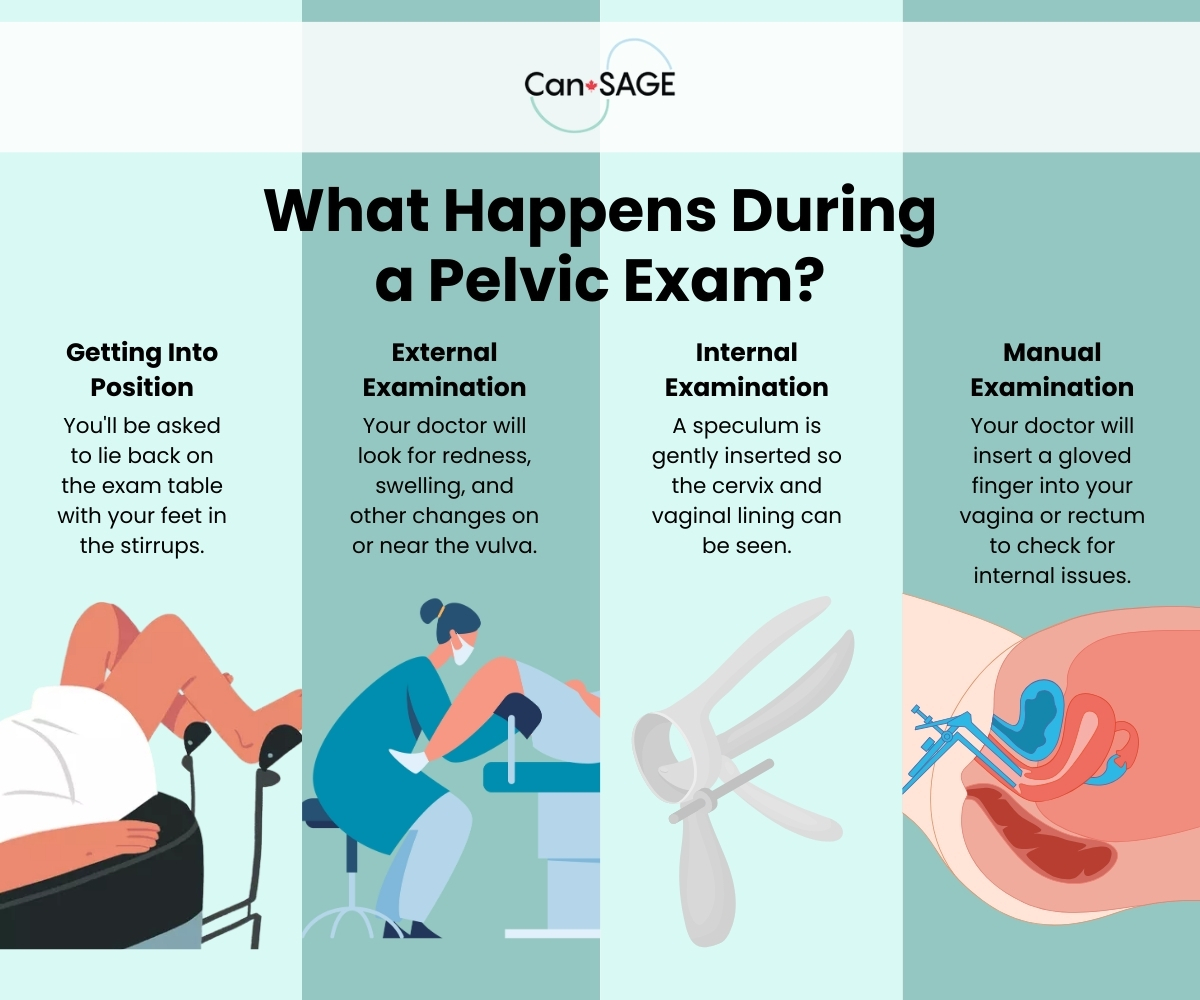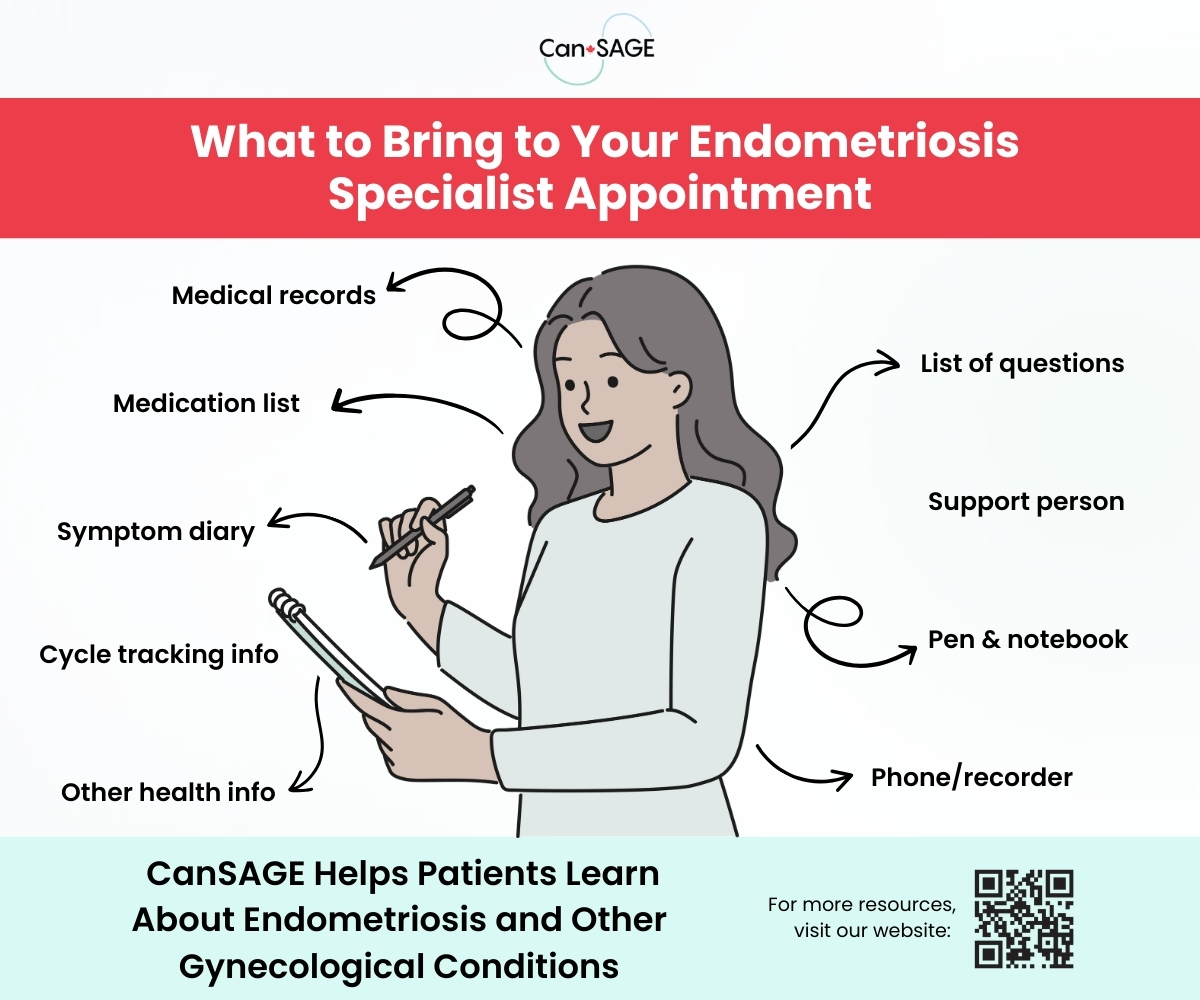Summary:
Preparing for your first appointment with an endometriosis specialist can feel overwhelming, but knowing what to expect and how to prepare helps. At your appointment, the care team will review your history and records, perform an exam, and discuss next steps. Writing down questions and bringing records, symptom notes, and medications helps you get more from the visit.
How to Prepare for Your First Endometriosis Specialist Appointment
It’s normal to have mixed feelings before seeing an endometriosis specialist for the first time, especially if you’ve been struggling to find answers for a long time. Many patients feel anxious, stressed, scared, nervous, or even a little bit overwhelmed when they aren’t sure what to expect.
Learning what typically happens during the first appointment, and knowing how to prepare, can make the process feel more manageable. It’s also the best way to feel more in control of your own health.
Below, you’ll learn what happens at the first visit, which questions patients like you commonly ask, and what to bring to the appointment. Download the free handout in the first section to print or save the info.
Download the Endometriosis Appointment Prep Kit
Want an easy-to-follow, step-by-step guide to keep on hand? CanSAGE’s Endometriosis Appointment Prep Kit is free to access and easy to download or print off:
- Click the button below to download the PDF file
- Save it as a PDF on any compatible device for digital access
- Print it off to create a paper copy you can fill out and/or bring to the appointment
- Use the checklist as a quick reference on what to bring and how to get ready
- Add your own notes in the blank sections at the end of the checklist
Download the Endometriosis Appointment Prep Kit PDF
How to Find Out the Date of Your Appointment
Specialists typically schedule an appointment as soon as a spot becomes available, then send out a notification by letter, phone call, email, or text a few days or weeks prior to the appointment.
Try to arrive 15–20 minutes early so you have time to check in and get settled before they call your name.
If you need to reschedule your appointment, think you might be late, or can’t attend for any other reason, call them and let them know right away.
What to Expect During The Appointment
The first visit is an important opportunity for you and your provider to get to know one another, ask questions, and create a game plan for treating endometriosis. After you’re checked in, someone will call your name and bring you into a private room just as if you were seeing your own family doctor.
Some patients see their specialist right away, while others meet with a nurse, resident, or assistant for intake first. The doctor will typically come in shortly afterward if this is the case.
Step 1: Getting a Detailed Medical History
Your care team needs to have a clear picture of your overall health and endometriosis symptoms in order to create an evidence-based treatment plan.
The team will want to get answers to the following types of questions:
- What brought you in today?
- Can you tell me a little about your symptoms?
- How long have you been struggling with them?
- Do you menstruate, and if so, are your periods regular?
- Have you noticed heavy or irregular bleeding?
- Is sexual intercourse painful for you (especially with deep penetration)?
- Do you find it difficult or painful to urinate or have a bowel movement?
- Do you experience any pain in your pelvis, abdomen, back, and legs?
- Does anyone in your family have endometriosis (if known)?
- Do you have any other pre-existing mental or physical health issues?
These questions can seem a little invasive at first, but they do help the doctor track down where any endometriosis lesions might be and how best to treat them. You may be asked these questions directly by either the doctor or someone on their team, or be asked to fill out a questionnaire to obtain this information.
If you’re struggling to find a clear way to describe your symptoms, try using descriptors like sharp, stabbing, pulling, aching, or burning.
Step 2: Reviewing Past Records
Looking at past records is an important part of the information-gathering process, and in some cases, can even help the doctor track the progression of your endometriosis over time. Some providers will handle this step in advance, while others might go over findings like these during the appointment:
- Imaging results from past ultrasounds, MRIs, or CT scans
- Surgical reports from any previous procedures (especially abdominal surgeries)
- Lab work, including hormone levels, inflammatory markers, and blood counts
- Pathology reports, if you’ve had surgery to extract endometriosis lesions in the past
- Prescription histories, to see what you’re taking and what you’ve already tried
- Notes from other providers that shed light on your condition and overall health
Keep in mind that the doctor may be unable to access records from other countries, provinces, or locations. Contact the office to ask in advance. They may be able to transfer your records over manually.
Step 3: The Physical Exam
Most providers will want to do a physical exam during the first visit. While it isn’t possible to confirm or diagnose endometriosis this way, it can still tell the doctor a lot about your gynecological health.
What Happens During a Physical Exam:
- You’ll be asked to change into a gown and given time to do so in private.
- Once you’re changed, you’ll lie down on the exam table with your feet in the stirrups.
- You may be asked to slide or scoot your body down to the end of the exam table.
- The doctor will quickly check your vulva and perineum for unusual signs, like swelling or redness.
- They’ll use a hand to press down on your outer abdomen to feel for tender spots or nodules.
- They might insert a speculum into your vagina to help them see your cervix and vaginal walls.
The doctor might also want to perform a bimanual or recto-vaginal exam. If so, they’ll insert a gloved, lubricated finger into your vagina and/or rectum, and may also press down on your abdomen gently, to feel for any unusual lumps or changes. This part of the exam doesn’t take long but is still very important.
Feeling nervous about this part of the appointment? Let the staff know in advance or on the spot—they can help by going slow and explaining what they’re doing at every step.
Step 4: Talking About What Comes Next
Next, you and your provider will sit down and talk about the next steps. They’ll confirm whether they suspect endometriosis and explain any potential treatment options.
The doctor might recommend:
- Additional tests, including MRI, CT scans, or blood work
- A referral to an obstetrician, fertility clinic, pain clinic, or surgeon, if required
- OTC or prescription medications like pain relievers, birth control, or hormone therapy
- Hormone-containing or copper-only intra-uterine devices (IUDs)
- Diet, exercise, counselling, and other miscellaneous lifestyle changes
- Pelvic floor therapy to address your pain and/or issues like prolapse
- Surgical options for the treatment of endometriosis
- Creating a schedule for follow-up visits to track any progress
Keep in mind that every patient is different. If the doctor recommends options that aren’t on this list, or you don’t understand why they’re recommending a treatment, ask for clarification.
Questions to Ask Your Specialist
You’ll have an opportunity to ask questions before the appointment ends. Creating a list ahead of time will make it easier to remember them in the moment.
The most common examples include:
- What do you think is causing my symptoms?
- Do I need more tests, and if so, what will they tell us?
- Does having endometriosis mean I need pap smears more often?
- How does my [other diagnosis] affect my endometriosis?
- What medications are you prescribing? How do they work?
- Is surgery the only way to know for sure if I have endometriosis?
- How can I manage my endometriosis pain day-to-day?
- What are the risks associated with my [medication/procedure/treatment plan]?
- How does endometriosis affect my ability to get pregnant?
- What should I do if pain, bleeding, or other symptoms suddenly get worse?
- How often should I come back for follow-up visits?
Bringing a notepad, pen, or recorder is a great way to capture what the specialist has to say during the visit. Just be sure to confirm if they’re okay with being recorded first.
What to Bring With You
A few weeks or months before the appointment, start compiling a binder full of important info to bring with you. Include anything that feels relevant or important, including:
- Your past medical records. Most provinces now allow patients to access a limited number of past records online via an app or portal:
- NS: YourHealthNS
- BC: Health Gateway
- AB: MyHealth Records / MyAHS Connect
- SK: MySaskHealthRecord
- PEI: My Health PEI
- QC: Carnet santé Québec
- NB: MyHealthNB
- NL: MyHealthNL
- A diary of symptoms, including bleeding, cramping, period pain, deep pelvic pain, pain during exercise, pain during sex, or pain when going to the bathroom.
- A list of current medications, including all current prescriptions, over-the-counter medicines, vitamins, minerals, and supplements. Ask your pharmacy for help with this.
- Cycle tracking info. Online apps like Natural Cycles or Flo make this easier, but some people prefer to just keep a journal or add a note to their calendar.
- A support person, like a partner or friend. They can hold your hand, be there for you, help take notes, or advocate for what’s needed on your behalf.
It’s also smart to include information about other health conditions, even if they’re unrelated to endometriosis. Some diagnoses (like a history of blood clots) can affect the treatment plan or even make it unsafe to take certain medications.
Take Control of Your Endometriosis Journey
Gynecologists and other specialists partner with nurses, assistants, and surgeons to deliver the best possible care every single day. You are an equally important member of the same team—and the only one on it who can share what it feels like to live with endometriosis from your own personal perspective. Taking an active role by preparing for appointments will help you stay empowered and in control.
Learn more about endometriosis: explore our Endometriosis videos page.




